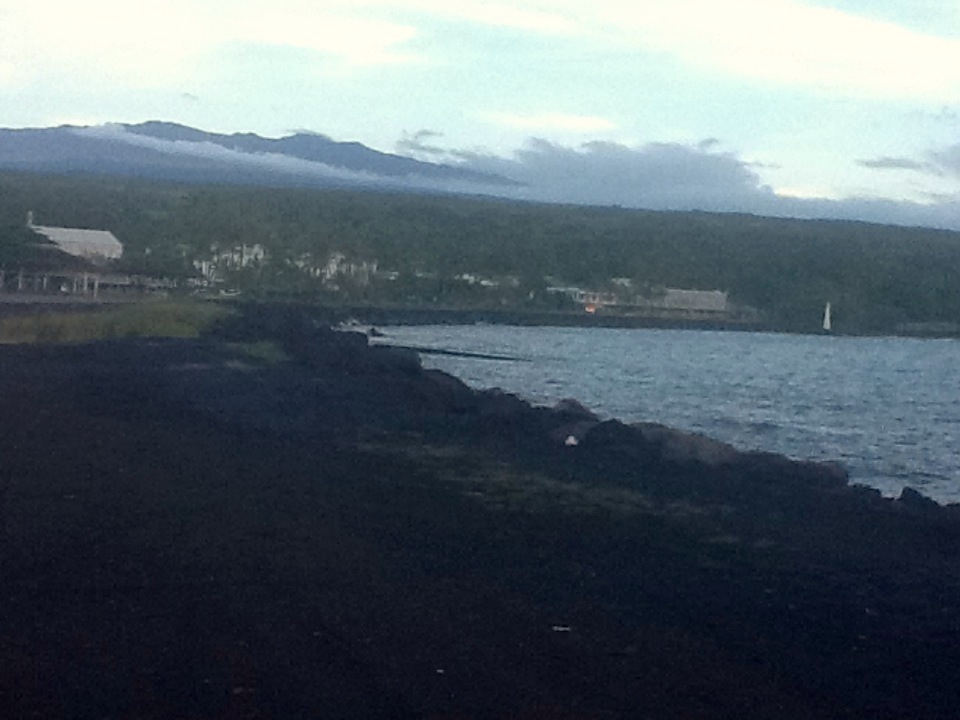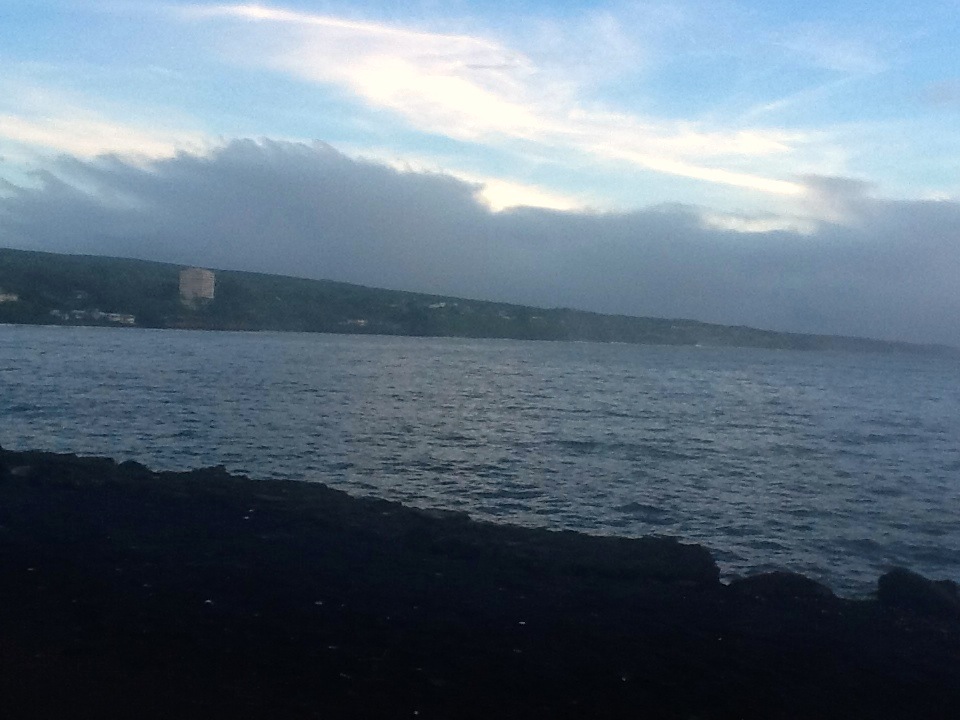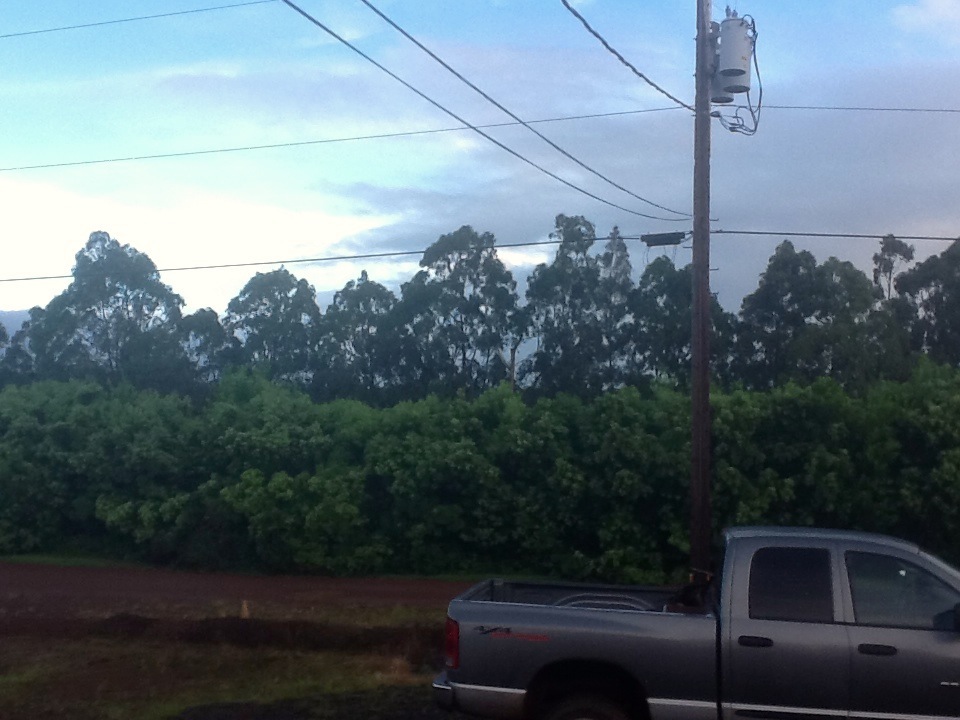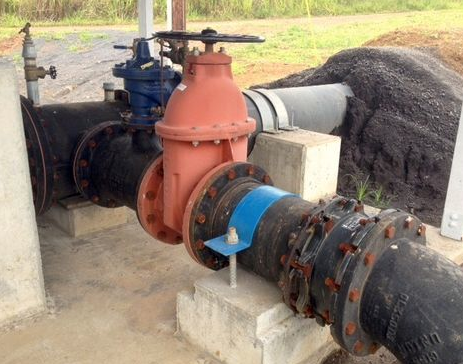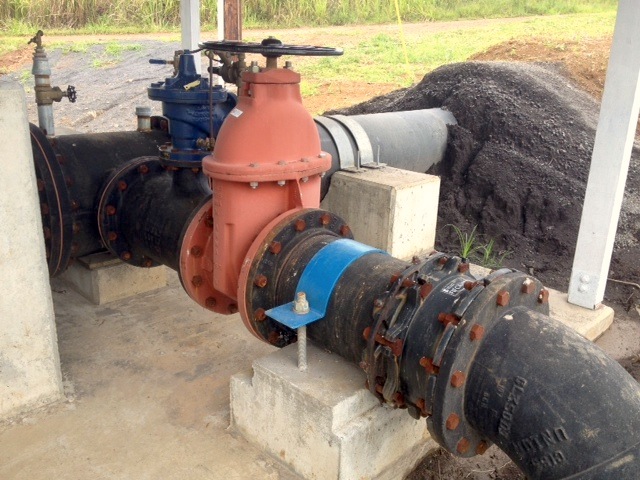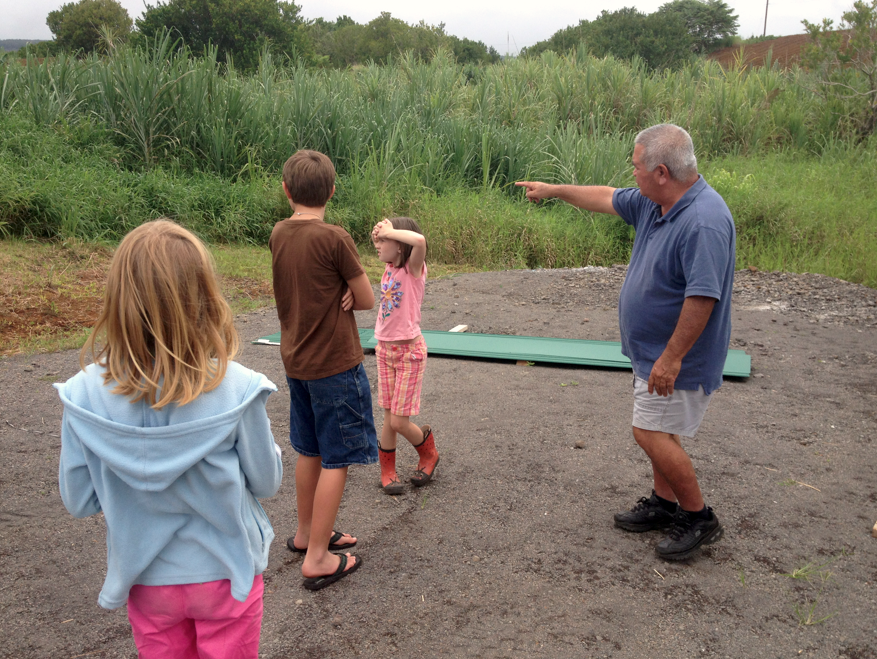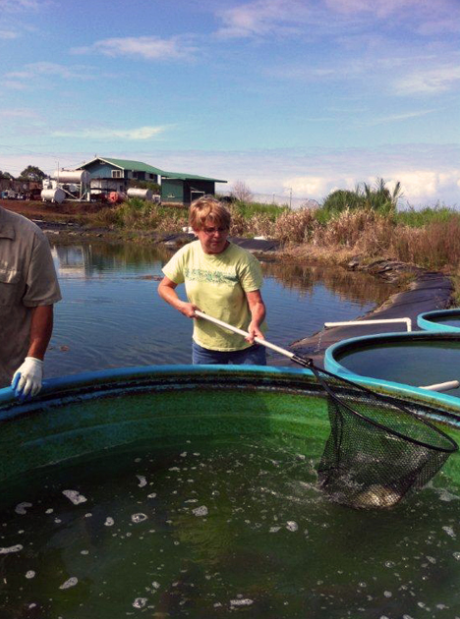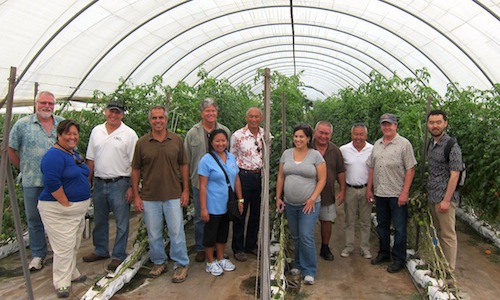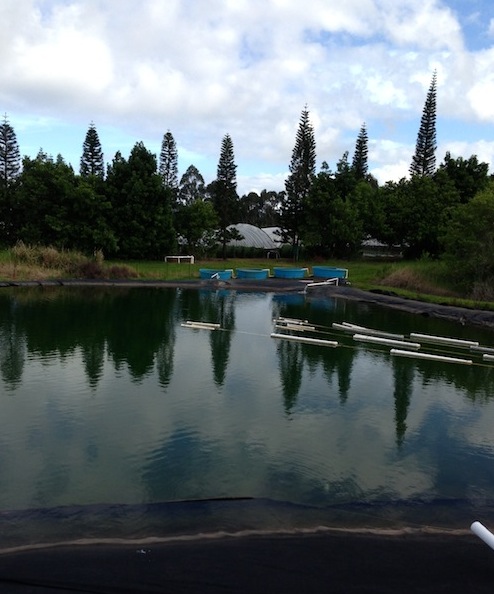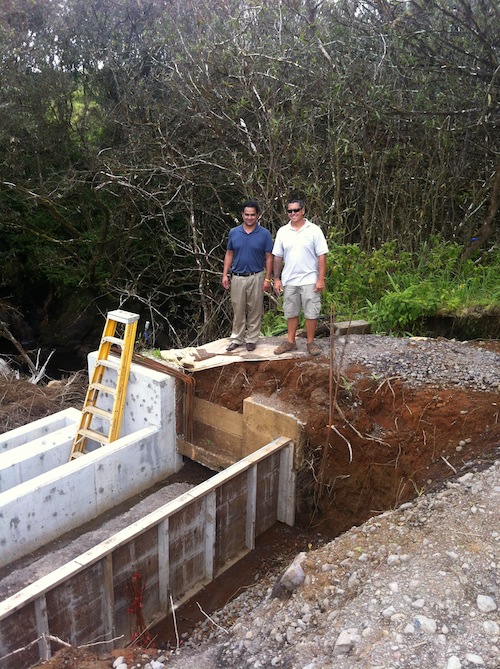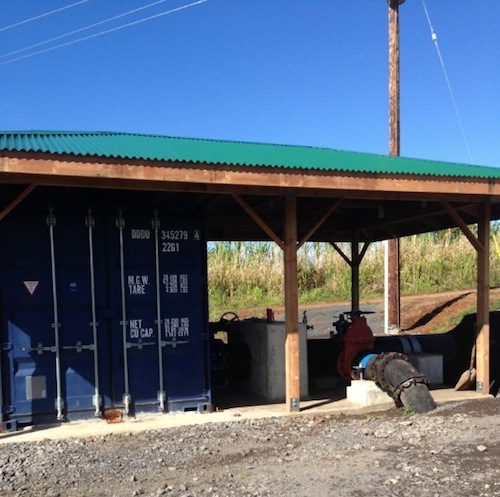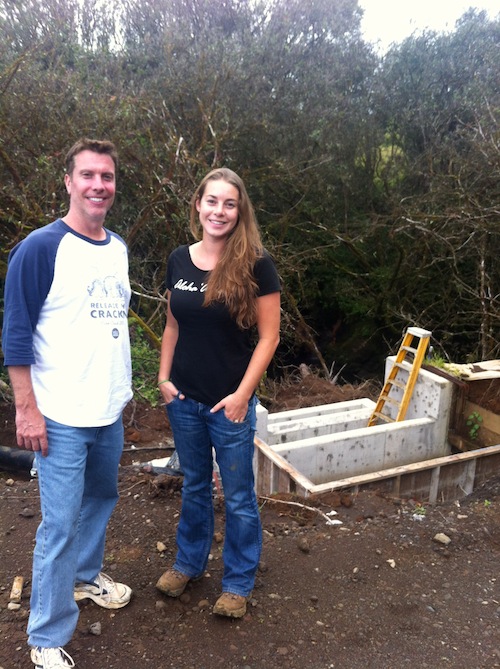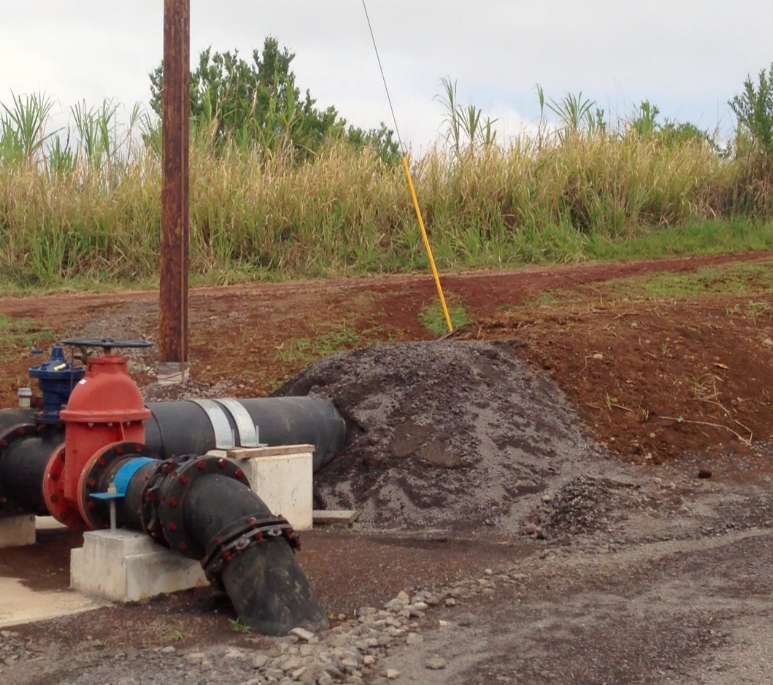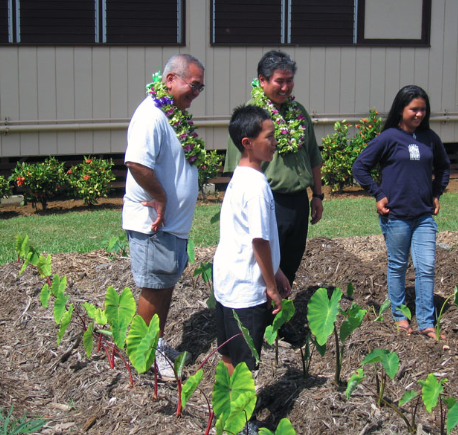Another article about the farm’s new hydroelectric system just ran in Pacific Business News.
Tag Archives: Hamakua Springs
A Farmer’s Perspective on Tropical Storm Flossie
Richard Ha writes:
We came away from Tropical Storm Flossie unscathed. We hope other farmers around the state were lucky, too.
I was up early this morning, and on my way to the farm I stopped by Hilo Bay to check out the storm. Last night they said it should arrive here around 6 a.m., and it sounded like it was going to be head on, coming straight at us.
We already know that 60 mph winds would take down our bananas, the ones in exposed places, and also our tomato houses. That’s why we planted our primary windbreaks to protect from north and south winds. They are serving that purpose well.
Because the sun moves across the sky somewhat to the south of directly overhead, we planted the windbreaks on the south sides of the roadways, so the shadows would fall on the road rather than on the plants. Farmers know that sun energy drives photosynthesis. Each leaf is a solar collector. But we must not restrict air movement too much, or fungus will thrive. There are lots of variables to consider.
So this morning around 6:00, I took these pictures at Hilo Bay.
I looked around and said, Holy smokes! The sun was coming up right behind me and I could see both mountains. I could see the top of Mauna Kea, and I could see the outline of Pepe‘ekeo point, clearly. That’s the point where the topography changes.
There was a north wind. The leading edge of the storm was blowing from the north. It wasn’t very strong, so I knew it was far away. Above the angry-looking clouds I could see blue sky, so it wasn’t very high and not very deep. That was significant.
Because we knew the storm was turning counter-clockwise, I predicted that as the storm went by it would increasingly be blocked by the slopes of Mauna Kea. As it kept moving and you could still see blue sky, sooner or later you would catch the back end of the storm where the wind starts blowing from the opposite direction. When it turned south, I thought, there did not appear to be much moisture-laden air to support heavy rainfall.
You could actually see it. I said early on that if this holds true to form, we should avoid the heavy rainfall we had expected. And that's how it turned out.
Farmers have to be able to do this sort of stuff. They’ve got to know how to watch the weather, and know how these things work, like planting windbreaks in the right places. We’ve seen what happens to plants that grow up against windbreaks. They don't grow as well without enough sun energy to support growth.
This morning we were at the farm, prepared for the worst-case scenario. We would have cut the ropes and let the plastic on our tomato houses fly,if necessary, instead of letting the wind twist the metal houses. Though if there was thunder and lightning, we wouldn’t have let our workers go out to do that. Worker safety comes first.
It’s very interesting to have seen it all happen and understood exactly what is going on.
Connecting Our Hydro to the HELCO Grid
Richard Ha writes:
We just received approval to connect our hydro project to HELCO's grid. We could not be happier!
We still need to work out the technical details. Normally, the Standard Interconnect does not allow the export of power back to the utility grid.
But we are not trying to get paid for the extra power. We want to save money by avoiding having to pay for special equipment.
The flume runs day and night and will generate twice as much electricity as we use. We want to give the excess to the grid, free-of-charge. Otherwise, it will be wasted – poho.
This event, connecting to the grid, is as momentous as deciding to move our farm to Pepe‘ekeo was many years ago. Plantations were closing down all over the state, and there were many options as for location. We could have moved to Waialua on O‘ahu. It would have been close to the market – O‘ahu.
But we made our final decision based on water. At Pepe‘ekeo, there were three streams and three springs. The water was free and it was going to be free for as long as we could see.
And now the free water will generate electricity!
Watch Richard on KHON Tonight (Wed) at 5 & 6 p.m.
Richard and his daughter Tracy were interviewed today by Olena Heu at KHON in Honolulu. The segment will be on the KHON News tonight at 5 p.m., with a shorter version of the interview at 6 tonight.
They were interviewed about food safety, which has been in the news lately. Tune in and hear about current food safety practices at Hamakua Springs, and how they are experimenting with ozone for food safety right now.
A transcript of the interview is here.
KHON streams its newscasts live here, if you want to watch live at 5pm HST.
The Wheres & Whyfors of Hamakua Springs
By Leslie Lang
The other day Richard gave some of us a tour of Hamakua Springs Country Farms in Pepe‘ekeo, and its new hydroelectric plant, and wow. I hadn’t been out to the farm for awhile, and it was so interesting to ride around the 600 acres with Richard and see all that’s going on there these days.
Most of what I realized (again) that afternoon fell into two
broad categories: That Richard really is a master of seeing the big picture, and that everything he does is related to that big picture.
Hamakua Springs, which started out growing bananas and then expanded into growing the deliciously sweet hydroponic tomatoes we all know the farm for, has other crops as well.
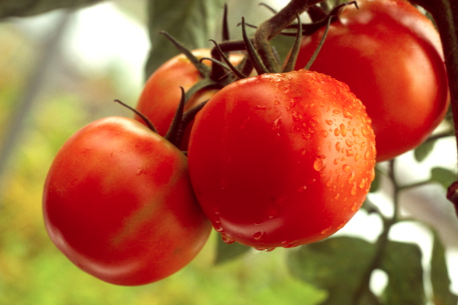
As we drove, we saw a lot of the water that passes through his farm. There are three streams and three springs. It’s an enormous amount of water, and it’s because of all this water that he was able to develop his brand new hydroelectric system, where they are getting ready to throw the switch.
The water wasn’t running through there the day we were there because they’d had to temporarily “turn it off” – divert the water – in order to fix something, but we could see how the water from an old plantation flume now runs through the headworks and through a pipe and into the turbine, which is housed in a blue shipping container.
This is where the electricity is generated, and I was interested to see a lone electric pole standing there next to the system. End of the line! Or start of the line, really, as that’s where the electricity from the turbine is carried to. And from there, it works its way across the electric lines stretched between new poles reaching across the land.
He asked the children who were along with us for their ideas
about how to landscape around the hydroelectric area, and also where the water leaves the turbine to run out and rejoin the stream.
“We could do anything here,” he said, asking for thoughts, and
we all came up with numerous ideas, some fanciful. Trees and grass? A taro lo‘i? Maybe a picnic area, or a water flume ride or a demonstration garden or fishponds?
There are interesting plans for once the hydro system is operating, including a certified kitchen where local area producers can bring their products and create value-added goods.
Other plans include having some sort of demo of sustainable
farming, and perhaps ag-tourism ativities like walking trails going through the farm, and maybe even a B&B. “The basis of all tourism,” he said, “is sustainability.”
Hamakua Springs is also experimenting with growing mushrooms
now, and looking into several other possibilities for using its free
electricity.
As we stopped and looked at the streams we kept coming
across, which ran under the old plantation roads we drove upon, Richard made an observation that I found interesting. In the Hawaiian way, the land is thought of as following the streams down from mountain to sea. In traditional ways, paths generally ran up-and-down the hill, following the shape of the ahupua‘a.
“But look at the plantation roads,” he said, and he pointed
out how they run across the land, from stream to stream. The plantation way was the opposite. Not “wrong” – just different.
Richard has plans to plant bamboo on the south sides of the
streams, which will keep the water cool and keep out invasive species.
At the farm, they continue to experiment with raising
tilapia, which are in four blue pools next to the reservoir.
The pools are at different heights because they are using gravity to flow the water from one pool to the next, rather than a pump. Besides it being free, this oxygenates the water as it falls into the next pool. They are not raising the fish commercially at present, but give them to their workers.
Everything that Richard does is geared toward achieving the same goal, and that is to keep his farm economically viable and sustainable.
If farmers make money, farmers will farm.
Continuing to farm means continuing to provide food for the local community, employing people locally and making it possible for local people to stay in Hawai‘i: This as opposed to people having to leave the islands, or their children having to leave the islands, in order to make a decent life for themselves.
The hydroelectric system means saving thousands per month in
electric bills, and being able to expand into other products and activities. It means the farm stays in business and provides for the surrounding community. It means people have jobs.
This is the same reason why, on a bigger scale, Richard is working to bring more geothermal into the mix on the Big Island: to decrease the stranglehold that high electricity costs have over us, so the rubbah slippah folk have breathing room, so that we all have more disposable income – which will, in turn, drive our local economy and make our islands more competitive with the rest of the world, and our standard of living higher, comparably.
When he says “rubbah slippah folk,” Richard told me, he’s always thinking first about the farm’s workers.
This, by the way, is really a great overview of how Richard describes the “big picture.” It’s a TEDx talk he did awhile back (17 minutes). Really worth a look.
It was so interesting to see firsthand what is going on at the farm right now, and hear about the plans and the wheres and whyfors. Thank you, Richard, for a really interesting and insightful afternoon.
Visitors To The Farm
Richard Ha writes:
We had a lot of visitors one day last week. All, like us, were very excited about the possibilities surrounding ag and energy at the farm. Agriculture and energy are inextricably intertwined.
The visit was arranged by Matt Hamabata, Chief Executive Officer of the Kohala Center, of which I am a board member. He brought researchers from Cornell University, as well as representatives from UH Hilo and Kamehameha Schools.
This reservoir supplies all the irrigation water for our vegetables. The water comes down from an intermittent stream. Soon, the water pumps that move the water and pressurize the lines will be electrified from the old plantation flume.
See the blue tanks in the distance? That’s a tilapia experiment, where we oxygenate the water by using falling water rather than electricity. This is another way to leverage the abundant water that falls on the farm: We get 2.3 billion gallons annually on our 600-acre farm.
We took them up to the head works, where the old part of the flume system joins up with the new. As we looked downslope, someone mentioned how amazing it is to think that the sugar people moved the sugar cane to the mill by portable wooden
flume structures that they moved from field to field. We were standing about three miles upstream of the sugar mill.
Next we went to the hydro turbine shack to see where the water we borrowed 150 feet upslope is returned to the flume after energy is extracted. From there, overhead lines take the electricity to our packing house.
Later, Laverne Omori, the new Research and Development Director, came by with County Energy Coordinator Will Rolston. Vincent Kimura, of the INNOVI group, was at the farm helping us install an ozone food sanitation system. The beauty of this system is that we won’t have to use chemicals for sanitation treatment.
The only thing left over will be plain water.
Here’s a “before” picture with some previous visitors, Claire Sullivan and Steve Carey from Whole Foods.
And this short video shows “after.”
We want to use the electricity we get from the river to help area farmers produce more food. The bottom-line, inescapable fact is that if the farmers make money, the farmers will farm.
Agreed: Local Products Shouldn’t Be More Expensive
Richard Ha writes:
Over the weekend, Scott Bosshardt of Kea‘au had an important letter to the editor of the Hawaii Tribune-Herald.
His point was that products produced and purchased locally shouldn’t be more expensive than the same product purchased abroad.
One extremely important fact that the “Think Local, Buy Local” proponents shouldn’t overlook is that local businesses need to “price local.”
Products produced and purchased locally shouldn’t be more expensive than the same product purchased abroad.
He also wrote:
“Price local” instead of as if our Big Island-grown tomatoes and coconuts were imported from half way around the world or some other planet, then people will be much more inclined to “buy local.” This holds true for everything we produce here. Think about it. When you live in Columbia, you don’t pay more for coffee than you do in San Francisco.
He’s right: Prices are higher here, and we need to lower them. It’s what I keep talking about. We need to find a way that we can lower our costs.
I first noticed our farm costs rising steadily back in 2005 and 2006. Rising costs affect every aspect of our farm, and it was very worrisome. Looking into it, I realized that the rise in price was due to the price of oil increasing.
Here in Hawai‘i, we are being squeezed extra hard. More than 70 percent of our electricity comes from oil. Compare this to the U.S. mainland – Hawaii’s primary competitor in many produce and food manufacturing categories – which relies on oil for only about two percent of its electricity generation.
As the price of oil rises, you can see how our local farmers and food manufacturers become less and less competitive with the mainland.
Farming is very energy intensive, and farmers’ refrigeration and water pumping costs have steadily gotten more expensive. Wholesalers’ and retailer refrigeration costs have gone up, too. This means food costs more.
Oil prices have quadrupled in the last 10 years, and this has put the economy into a continuous recession. Everything has been squeezed. Government workers’ pay has been cut. Electricity costs have gone up steadily. School budgets have been squeezed. Medical costs have risen.
I have so far attended five annual Association for the Study of Peak Oil (ASPO) conferences trying to figure out how to protect our farm from the rising price of oil. I don’t have a degree in chemistry or the sciences – but I am a farmer with common sense. So I spent my time figuring out who I can trust for good information
I determined that the folks at ASPO can be trusted because they have no other agenda than to produce good information. It is up to me to decide if their studies are valid or not, or whether I agree with their conclusion. On the other hand, I thought that people whose livelihood depends on putting on a happy face would probably just put on a happy face.
I have learned that the world has been using two to three times as much oil as it has been finding, a trend that continues. I’ve learned that the oil being produced now is much more expensive than what they found 50 years ago. It takes more energy now to get the energy. The cost of producing oil from shale and oil sands was $92 per barrel in 2011, and the floor price of oil is probably not much lower than that.
The era of cheap oil is over. And the stuff produced in the future will be even more costly, setting a higher floor as time goes by. Unless we do something, it will squeeze us all even more.
Look around: It is happening right now, even with a banner tourism year. Imagine what it will be like if we have a significant downturn.
Also important to note is that the rubbah slippah folks have less and less discretionary income. Consumer spending makes up two-thirds of our economy. Our consumers will have more spending money when we can lower the cost of our electricity.
What about the happy news that the U.S. will become the largest producer of oil and gas in the future? In 2009, Art Berman, a petroleum geologist, showed that in a study of 4,000 gas wells in the Barnett Shale, most of the production came out in the first year. Sixteen-thousand wells later, we see that 90 percent of shale gas and shale oil wells were more than 90 percent depleted within five years. And the decline rate for all the wells is more than 30 percent. We will need to drill one third as many we have now just to keep production steady.
One can reasonably conclude that the shale gas and shale oil phenomenon may not be a game changer. It probably won’t make a large dent in world oil production.
Meanwhile, the overall trend continues. Most of the world’s oil is produced by giant and supergiant oil fields, and lots of them are declining. Folks who study this estimate that the decline rate is around 4 to 6 percent annually. That is about 3 million barrels a year. This is going on all day, every day, no matter what the stock market does.
What can we do on the Big Island to lower electricity costs, and the cost of locally produced food? Biomass and geothermal can do that today. There may be other choices maturing in the next few years, too.
Producing electricity from geothermal here costs half as much as producing it from oil. And the Big Island will be over the hot spot that provides us with geothermal for 500,000 to a million years.
Iceland is pulling itself out of the largest financial crash in history because it has cheap electricity from geothermal and can export fish.
Let’s say that one wanted to payoff an oil-fired plant that produces 60MW today. That difference in price would save $6,600/hour and $158,400 /day. This is more than $50 million per year. Seems like we could be creative with writing off stranded assets.
We are very lucky to have these options here.
Read more about this:
Testimony to OHA Supporting Geothermal
Richard Ha writes:
OHA is contemplating investing in geothermal. I am in favor of that, for the reasons that I mention below.
I sent the following testimony to OHA:
***
Subject: OHA testimony re: Huena Power Co/IDG
April 17, 2013
Office of Hawaiian Affairs
711 Kapiolani St.
Honolulu, HI 96813
Aloha Chair Machado and Board members of OHA:
The Geothermal working group report, which Wallace Ishibashi and I co-chaired, recommended that geothermal be the primary base power for the Big Island. OHA was represented on the working group by trustee Robert Lindsey.
I believe that OHA should participate in geothermal development because it is an income source for OHA to provide services to the Hawaiian people. And it can influence the course of our people’s history.
Geothermal-generated electricity is proven technology, affordable and environmentally benign. The Big Island is expected to be over the “hot spot” for 500,000 to a million years so its price is expected to be stable.
The Pahoa School Complex in Puna, at 89%, has the highest number of students in the State who participate in the free/reduced school lunch program. Participation is related to family income. The Big Island has had electricity rates 25% higher than O‘ahu’s for as long as anyone can remember. So a large portion of the school budget, that should go to education, goes instead to pay for electricity. Yet the best predictor of family income is education. A lower electricity rate, generated by geothermal, will have a direct effect on education. And if OHA, through its influence, emphasizes education in the community, there will be even more positive results.
Rising electricity rates act like a giant regressive tax. The folks on the lowest rungs of the economic ladder are affected disproportionately. Those who can leave the grid, leave. Those who cannot leave end up paying more for the grid. Too often those folks will be Hawaiians.
Hawaiians should be able to live in their own land. Yet there are more Hawaiians living outside of the State, because they needed to move elsewhere to find jobs to raise their families. Exporting our children is the same as losing our land. OHA is in a position to drive the agenda so Hawaiians can afford to live at home.
During the development of the Geothermal Working Group report, Rockne Freitas arranged a meeting with Carl Bonham, Executive Director of the University of Hawai‘i Economic Research Organization (UHERO), and some staff.
I asked Dr. Bonham two key questions: “Is it fair to say that if the Big Island were to rely on geothermal energy for its primary base power as oil prices rises, shouldn’t we become more competitive to the rest of the world?” He said that was fair to say.
I asked: “Then is it fair to say that our standard of living would rise?” He said: “Yes.”
I am a farmer on the Hamakua coast with family ties — Kamahele — in lower Puna. I farmed bananas at Koa‘e in the late 70s and early 80s. I have been to five Association for the Study of Peak Oil (ASPO) conferences. I went to learn and to position my business for the future. I found that the world has been using two and three times the amount of oil than it has been finding for more than 30 years and that trend continues. The price of oil has quadrupled in the last 10 years.
Until the first ASPO conference, I was just minding my own business, being a banana farmer. But what I learned became my kuleana. I did not ask for it.
Until last year, when Kamehameha Schools sent Giorgio Calderone and Jason Jeremiah and Noe Kalipi went to the conference, I was the only person from Hawai‘i to attend. The subjects were always data driven and conclusions could be duplicated.
We have the resources here to dodge the bullet. We need to drive a clear agenda for the benefit of all the people, not just a few.
One of the controversial issues in the Puna district is H2S gas. I went to Iceland and sat in the Blue Lagoon, where a geothermal plant within a quarter mile emits geothermal steam into the atmosphere. Millions of tourists visit the Blue Lagoon for health purposes.
There are small geothermal wells within the city that are used to heat the residences and businesses. If you did not know what to look for, you wouldn’t even know they were there. I walked by and touched the walls.
A long term study of the effects of H2S on people who suffer from asthma was just completed. It was done in Rotorua. They found no correlation of asthma to daily ambient H2S levels of 20,000 parts per billion over a three-year period. The study indicated that there might be a beneficial effect because it relaxes the smooth muscles. See link above.
The human nose can detect levels of H2S at incredibly low levels: 5 parts per billion. The Department of Health requires reporting when levels exceed 25 parts per billion. The Rotorua study was done for three years at average levels that were 20,000 parts per billion. OSHA allows geothermal plant workers to work in a 10,000 parts per billion environment for 8 hours per day without a mask.
Wallace Ishibashi and I went to the Philippines with the delegation that Mayor Kenoi put together. We visited a geothermal plant that sat on a volcano that last erupted 100,000 years ago. Mauna Kea last erupted 4,000 years ago. We may have more resources than we know.
The Phillipines and Hawai‘i started geothermal exploration at the same time. They now have in excess of 1,200MW, while we have 38MW. We are so far behind them, a supposedly Third World country, that it is embarrassing.
OHA is in a unique position to be able to influence the future. It is as if we are getting ready to duplicate that first voyage from the south so many years ago. It’s not whether or not we are going. It’s who should go, and what should we put in the canoes? Mai‘a maoli? Popoulu? What else?
Richard Ha
President, Mauna Kea Banana Company
I am a member of the Hawaii Clean Energy Steering Committee, Board of Agriculture and farmer for 35 years.
Our New Hydroelectric System Is Almost Online
Richard Ha writes:
Our new hydroelectric system is almost ready to go.
We received a County permit to put a power line under the single lane County road, and that was finished several weeks ago. All the overhead lines are in place now.
All we need to do is hook up the ends and we will be generating electricity from the river.
Our vision is to use the electricity to help area farmers consolidate and ship their produce to market along with ours.
Our hydro project is an attempt to stabilize farmers’ costs. Farmers and food manufacturers here in Hawai‘i – where we use oil for more than 70 percent of our electricity generation, compared to the Mainland where they use oil to generate only 2 percent of their electricity – are at a disadvantage when it comes to importing food products.
Lots of veteran Big Island farmers are considering selling, instead of passing their farm on to the next generation. The quadrupling of energy costs in the last 10 years had been just too hard for them to adjust to.
Our farm uses approximately 30 kilowatts of electricity, and we will generate more than 70 kilowatts.
We’re asking people for ideas about what to do with the excess electricity. One idea is to cold treat temperate fruit and fool it to think it’s growing in Washington, sort of like what they did at NELHA. I that case, they ran cold water by temperate crops and gave them the cold treatment that way.
Any ideas?
What Is That Circle Around Us?
Richard Ha writes:
A bunch of things are happening right now. They look very different, but see if you notice what they all have in common.
We are just seeing the tomatoes start to produce more in spite of the dark, wet weather. It’s the third week of February; and last year, too, our tomatoes’ rate of production started climbing in the third week of February. That gives me a good feeling, because I’d been looking around and anticipating this.
All around I see growth. Avocado trees everywhere are choke with flowers right now. The ‘ulu are starting to develop on the tree; the ones I’m watching are about baseball size right now. Everything’s growing and producing around us.
We spent Saturday in Kona at a get-together for Armstrong Produce and its farmers. We stayed there for several hours, talking story with everybody.
I was sitting next to Timothy Choo, a chef from Sodexho, which does food service for UH Hilo. Sodexho is a huge supporter of local products, they go out of their way to buy locally, and we had a big conversation about it. Sodexho is supplied by Suisan, also a big supporter of local products.
I was also talking to Troy Keolanui, manager of OK Farms. Ed Olson owns that farm, 200 acres of many kinds of fruit and other trees, and we help distribute their produce under our Hilo Coast brand.
They are located behind Rainbow Falls, and they have a tent, with chairs in it, where they can sit and look at the falls. They purposely set it up behind some bushes so it doesn’t disrupt the more common view of Rainbow Falls, the one that tourists look at every day.
Then we drove back to this side of the island and went straight
to Puna. Chef Alan Wong was there, and he was throwing a small dinner for the farmers he buys from here.
Alan Wong and I started talking about the Adopt-A-Class project. I
said, “Why don’t we do a broader Adopt-A-Class project this time, in Puna. We’ll take the whole district and go to each of the schools there, including the charter schools. Everywhere there are elementary school kids.”
He’s into it. When we did this in the past, Alan Wong gave a class at Keaukaha Elementary School where he showed the kids how
to use tomatoes, and passed tomatoes around and had some of those kids eating, and loving, tomatoes.
Then yesterday, the folks from Zippy’s came by the farm. They’re going to open up a restaurant at Prince Kuhio Plaza soon and we’ll be supplying some of their products. Zippy’s has a strong “support local” program. When you go into any Zippy’s restaurant, you always see signs about which farms they get some of their products from. Zippy’s also uses local beef. It’s a corporate decision to support local growers.
Do you see the common link among all these things? Everybody’s coming at it from a different point-of-view, but the common
denominator is that we are so lucky to live here in Hawai‘i!
It’s all about local food and making ourselves food-secure. Our tomatoes are thriving and plentiful; where else in the country can you grow tomatoes throughout the winter? Other food is growing all around us.
Armstrong Produce distributes the products of many local farmers and producers. So does Suisan. Sodexo buy that local food.
And Alan Wong, too, is very interested in supporting local farmers and teaching local school kids. He’s very aware of the movement to be self-sustaining and is always reaching out to teach kids about where they come from, how their parents used to live and how we can live now. He’s all about helping people be grounded, and he comes at it with the training of a very high-level chef.
People are really helping each other out. Everybody has to make money, but they’re looking after the next person in the chain. If you’re the farmer, you’re hoping that your wholesaler is caring about you and not just the retailers. Everybody is look after everybody else.
It’s the only way I can figure out that we can help our own workers. Because, of everyone, who’s going to protect the workers? I’ve got to do everything I can to protect them.
There’s a big circle of sustainability around us, and it’s one that’s getting bigger and bigger. It’s really incredible, though it’s easy to get caught up in our busy lives and forget to notice.

